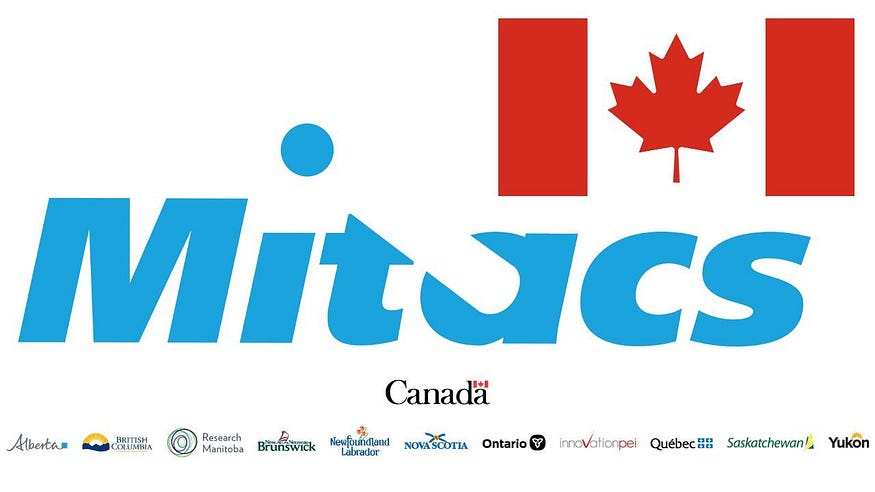
MITACS Globalink Research Internship | How to get one?
Last Updated on July 26, 2023 by Editorial Team
Author(s): Raman Jha
Originally published on Towards AI.
MITACS Globalink Research Internship U+007C How to get one?

Let me introduce myself first.
Hey there, I am Raman Jha, a junior year Bachelor of Engineering student at D Y Patil College of Engineering which is affiliated with Savitribai Phule Pune University, Pune. I got selected for Mitacs Globalink Research Internship’22 for Dalhousie University, Halifax, Nova Scotia, Canada. I will be working under the guidance of Professor Andrew Rutenberg. My project is titled “How do organismal scales interact during aging and death using Machine Learning?”. In this project, We will be modeling aging from a physics perspective, to understand the variability of individual aging trajectories, the interactions between health deficits, and the mechanisms of observed aging phenomenology. This project is currently using the Dynamic Joint Interpretable Network (DJIN) deep-learning model to study the aging of model organisms or to study the effects of chronic diseases. I will be working on training the DJIN model with multiscale data, to determine how these scales interact. This project can immensely contribute to the research of #aging, #machinelearning, and #deeplearning.
So, now let's get started with my voyage of Mitacs GRI coming ahead!!
This all started in the last week of May 2021, when I came across a repository by Hima Ahuja which contained almost all the Research Internship for Undergraduates. After knowing about Mitacs Globalink Research Internship through this repository, I knew that this is the internship that could provide me with an international research experience and an exposure that was unprecedented for me. I did not have many things at that time to showcase my skills. I got a research internship at IIIT, Lucknow in June and that really helped me build my profile for this internship. I worked on predicting heart disease from the UCI dataset. After that, I also got selected for Script fellowship’21 where I worked on a machine learning project called “Craftbrain”.
Now, after reading this you must be thinking about what exactly this internship is all about? Will it be like a summer research program or will it be a summer school? What about funding, will I also get funded for that? Will this be an in-person or will it be a remote internship? How will I be managing my expenses? And this list will only go on, I can totally understand that because once I also had these questions.
So, through this blog, I would try my best to answer most of the relevant questions about this amazing opportunity that would definitely change your life and provide you a chance to work in Canadian universities and their labs. It would also provide you an opportunity to collaborate with some of the finest persons in research while you will be completing your undergrad and that too with a decent stipend:)

Now we should start with some basic questions which normally every aspirant has when they heard about this internship.
- What is Mitacs Gloabalink Research Internship?
As stated on the official website of Mitacs “The Mitacs Globalink Research Internship is a competitive initiative for international undergraduates from the following countries and regions: Australia, Brazil, China, France, Germany, Hong Kong SAR, India, Mexico, Tunisia, United Kingdom, and Ukraine. From May to October of each year, top-ranked applicants participate in a 12-week research internship under the supervision of Canadian university faculty members in a variety of academic disciplines, from science, engineering, and mathematics to the humanities and social sciences”.
In other words, this is one of the best opportunities in the world for a growing researcher like you to obtain international exposure and collaborate with some of the best researchers in academia. It will provide you with a chance to contribute to some interesting and real-life research-based projects. The duration of the program is 12 weeks(May to October). The unique part about the research program is that the start date and the end dates are dependent on the availability of the selected intern. You can start your project anytime from 1st May to 31st July. You will be required to work 40 hours per week under a Canadian professor at the university where you got selected.
2. Why is this internship so prestigious?
Here are some crucial points which make it prestigious:
1. International exposure: As this is an international internship, so many interns will come from different parts of the world. This internship provides interns with an opportunity to meet with multinational people. It will help them to collaborate as well as learn from each other.
2. Technical exposure: Miatcs Globalink research Intern will have the access to one of the best research labs in the world, they will work on hand-on research, and they will also collaborate with many finest researchers for their research projects.
3. Globalink Graduate Fellowship: As per their official website “The Globalink Graduate Fellowship provides $15,000 in financial support to former Globalink Research Interns who return to Canada for full master’s or Ph.D. programs, or Postdoctoral fellowships at any Mitacs partner institution. Globalink alumni may apply for the fellowship at a different university than their Globalink Research Internship host institution”.
4. Competitive: In this internship program, applicants from around the world from the selected countries apply for it and that is what makes it highly competitive for other applicants.
5. Stipend: Mitacs offered a decent stipend to its interns for this Gloabalink Research Internship. At this time, it is happening offline, so I can confirm you that the amount is sufficient to manage the expenditures and stay for 12 weeks in Canada.
When it comes to funding, it covers your airfare, visa, living stipend, daily allowances, and also an allowance for COVID-related expenses. (It is around 8500+ CAD for this year). This time the internship is happening in-person mode(Thank god, this time it is not in virtual mode) after two years and the stipend depends on the stipend partner sometimes it’s Mitacs + AICTE or Mitacs + Shastri-Indo Canadian institutes, check more on this. As seeing this amount, you must have figured out that this amount is sufficient for a 12-week research internship in Canada and also if you will spend it wisely then you can also save a lot after wandering to some places and exploring them in Canada.:)
I am sure that reading these things has pumped you up for this research internship program. Even you have started imagining yourself as a Mitacs GRI’23.
So before all of that let us come to the technical part of this internship.

The eligibility requirements for this program for 2022 are as follows(It is almost the same for many years, so don’t worry about the upcoming year):
1. Be at least 18 years of age at the time of application
2. Be enrolled in a full-time undergraduate or combined undergraduate/master’s program at an eligible institution (see list of eligible institutions by country)
3. Have one to three semesters remaining in their program as of Fall 2022
4. Meet the grade requirements for their country of study (see GPA requirements for each international partner)
5. Apply to a minimum of three and a maximum of seven projects and ensure selections are from at least three different Canadian provinces
6. Be fluent in the oral and written language of the project (English and/or French)
7. Be available to complete an internship lasting 12 consecutive weeks between May 1 and October 31.
I hope you met all the requirements for this internship program. Now let’s move to the application process for this internship.
Application Opening and closing dates:
Normally this research application starts in the second week of August and ends in the third or fourth week of September. (In my case, the application started on 10th August 2021 and the deadline for the application was 22nd September 2021). As you will have more than one month for your Mitacs GRI application, so utilize it very well. Do not take it for granted. Start writing about your research experience and about your profile(It will be elaborated in the upcoming section)from the start of the application and also get reviews from your friends and relatives on it. As I have mentioned earlier that I was deeply interested in this program, so I subscribed to their newsletter, which helped me know about the date when the application opened for this program.
Application Process:
Mitacs has its own application portal for this research program. You need to register with your email ID and password on this portal. After this step, you will be inside your application. Now the actual application process starts. I will try my best to answer all your doubts and queries in each section.
Person Details section — In this section of the application, Here you are supposed to fill your personal details like full name(write as per passport), DOB, country of residence, citizenship, your address, and some other similar questions.
Educational Details section — This section is used to know your current educational background like university name(you can also search for your college name if your university name is not there), GPA till 4th semester, the course you are enrolled in, country etc.
I have seen this that before Mitacs GRI’22, many interns have talked about SOP and research rationale which was not there in my case. There were three questions which were responsible for assessing a applicant’s profile. The three questions are mentioned below:
1-General Description of Skills, Background, and research interest and experience(100 Words) — This question is designed in a way to evaluate your overall profile for this research internship. It requires your technical skills which you possess, your previous background in your field of interest, your particular research field of interest and then at last your experience in that particular research field. Remember that have a word limit of 100 words, so be precise with your words and write according to your profile.
2-Notable Achievements(100 Words) — In this question, you need to provide your undergraduate acheivemetns which you think is relevant with your application. You can add things like your participation in any hackathon, seminar, coding challenges etc. You can also precisely describe your projects here if you want to. If you have any technical writing experience in the relevant field or you have published technical articles on any website, then do mention them also. Remember the word limit is again 100 words.
3-Briefly describe the research work you have completed(100 words): Describe any research work which you have done or currently doing in this question. Your relevant research experience will immensely help you to stand out among other applicant. You should show how you have done your research work and how you are a research based person?(remember to be precise).
MCQ based section — Answer honestly about some basic questions.
Experience with Mitacs — Here you are needed to specify how you got the knowledge about this Mitacs Goabalink Reaserch Internship program like Mitacs official website, university portal, or from a Mitacs GRI alumni.
Letter of recommendation — Mitacs require you to submit atmost 2(Atleast one is required)Letter of Recommendation. It provides you 2 options for uploading your LoRs: Either you upload a combined pdf of your both LoRs or you provide the recommender’s details(Like Name and Email Id)and then they would receive a mail to submit LoRs. You can choose either of the options or both options(In my case, I chose both because one of my professor sent me his LoR, so I uploaded that on Mitacs portal and the other professor uploaded it by herself). You should let your professor know behorehead for this reommendation letter, so that they could provide you a strong recommendation letter. This is an important factor that would stand you out from others if you have worked under a professor, or attended a class actively. You also need to ensure that if only industry-based or only academic-based LoRs are allowed.
Projects — This is the most important part of your application. Your major chances of getting selected for this internship is dependent on your project selection. We will discuss this in detail in the upcoming section.
Documents — At the end, you need to provide your Curriculam Vitae and and transcripts(For your official trnascripts you need to apply to your home university, it is a week-long procedure so make sure you acquire them as soon as possible before the deadline of your application. You can apply with your unofficial trnascripts also. It will also do the work. I have confirmed this with other Mitacs GRI alumni as well as from Mitacs.)
Submit your application and now you have completed your Mitacs Gloabalink Research internship application. You should now work on sharpening your skills so that they will help you in your interview with your professor.
Let’s through some light on the most important section of the application: Choosing Research Projects.

Now in this section, I am going to elaborate on the methods through which choosing a research project would be an easier task and would also help you in making the right decision according to your profile. I have also added my personal tips for your reference.
You can choose a minimum of 3 research projects and a maximum of 7 research projects, but there is a restriction that no more than 3 projects can be selected from the same province. (Canada is divided into provinces like Alberta, British Columbia, Manitoba, New Brunswick, Newfoundland and Labrador, Nova Scotia, Ontario, Prince Edward Island, Quebec, and Saskatchewan). So you have to choose only 3 projects from any province mentioned above, but not more than 3.
Here are some important points that must be taken into consideration while choosing a research project(in my time, there were more than 3000 research projects were available on the Mitacs portal):
1. You should choose a project which is relevant with your field of interest or you have experience with. It will show that you know about the project and you also have the interest and skills for that.
2. You should carefully evaluate the projects by reading the description, student roles, and required skills, provided in the details of the project.
3. Mitacs provides a really helpful and useful platform to choose projects by applying filters like — keywords, province, host professor name, host university name, language(English/French).(In my case, I was interested in machine learning, so I used filters like machine learning, deep learning, and computer vision).
4. Make a priority list of the projects(2-Ambitious, 4-target, 1- safe). You will get a chance to rank your projects according to your preference. The 1st project will be your top priority and the 7th project will be your least preference.
5. You should also check the expected language of your project(English/French).
For choosing the final project list, I would suggest you make a list of projects with project id, project details, and host university name. This will help you to filter out those projects which you do not find relevant to your profile.
Personal tip: From my experience with Mitacs, I can say that having earlier experience in research will help. As it will help you to write about your research interest and experience. It will also give you some base to talk about in an interview with your professor.
So, I would recommend you to try to work under a professor or do a research internship. If you have any publications in the relevant domain, then your profile is already having an edge over other applicants. If you are just getting started with the things then, I would recommend you to explore as many fields(Web development, Android Development, Machine Learning, Cyber Security, Internet of Things, etc.)as possible, so that you can know your field of interest.
If you do not have any experience that’s also totally fine. You can definitely compensate for that with your personal projects. You should show that you have done relevant projects which can show that you can also work on these research projects. So you need to be good at either of them.
Your application procedure is completed !!!
After completing the application, what will be the upcoming procedures?
Now Your profile will come under these three categories:
1. Candidate Under consideration — Your application is forwarded to host professors of the 7 projects chosen by you when you were filling your application. Now, it’s in their hand, they will review and decide for the interview and other procedures for the selection of the research internship.
2. Waitlisted — Your application is still valid, but it is not yet forwarded to professors of the host university you applied for.
3. No longer consideration — Either your application has some issues due to which your application has been discarded or you are not eligible for the internship for any other reasons.
Review Process Begins!!

In this phase of the Mitacs GRI selection process, some professors might ask you for a Skype/Zoom interview. Some professors could also ask for a research proposal or would provide you with some tasks that need to be completed in a specified time.
On 22nd November,(the last date of the interview)I was interviewed by just one professor, which got me selected for Mitacs Gloabalink Research Internship(This project was my target project). In the first interview, he didn’t get into many technicalities, he told me that I will be working in a team with another intern and he was looking satisfied with my answers. After that day, he sent me three research papers that he was working on to publish on the same project. In the second interview On 3rd December, he gave me conditions and asked questions related to that. He told me what he is looking to achieve in the upcoming summer of Mitacs GRI’22 through this project. Things were pretty clear after that meeting and he also explained me the whole project thoroughly. The first interview was of 20–30 minutes and the second interview was of 40–50 minutes.
The first phase of results comes in December-January(I got my results in 1st phase). You will also be provided an option of re-ordering your project list as well. The second phase of results comes in February-March. If you are selected for this internship, then you will receive an offer letter from Mitacs.
My personal takeaways from this program:
1. After completing your application for Mitacs GRI, you should focus on enhancing your research profile, do not wait for results.
2. Take each rejection as learning. If you are not selected for this research internship, you might get selected for other.
3. You should be honest in your application as well as in the interview process.
4. You should broaden your knowledge in atleast those 7 research projects which you have applied for. It will immensely help you in your interview process.
I wish you all the best for your upcoming Mitacs Globalink Research Internship application and the journey coming ahead.
Feel free to connect with me on LinkedIn: https://www.linkedin.com/in/jhakrraman/
References :
[1]https://blog.codingblocks.com/2021/a-walkthrough-mitacs-globalink-research-internship/
[2] https://www.mitacs.ca/en/programs/globalink/globalink-research-internship
[3] https://www.mitacs.ca/en/programs/globalink/globalink-graduate-fellowship
[4] https://www.quora.com/What-stipend-do-MITACS-Globalink-interns-from-India-get
[5] https://www.mitacs.ca/en/programs/globalink/globalink-research-internship
[6] https://globalink.mitacs.ca/
Join thousands of data leaders on the AI newsletter. Join over 80,000 subscribers and keep up to date with the latest developments in AI. From research to projects and ideas. If you are building an AI startup, an AI-related product, or a service, we invite you to consider becoming a sponsor.
Published via Towards AI
Take our 90+ lesson From Beginner to Advanced LLM Developer Certification: From choosing a project to deploying a working product this is the most comprehensive and practical LLM course out there!
Towards AI has published Building LLMs for Production—our 470+ page guide to mastering LLMs with practical projects and expert insights!

Discover Your Dream AI Career at Towards AI Jobs
Towards AI has built a jobs board tailored specifically to Machine Learning and Data Science Jobs and Skills. Our software searches for live AI jobs each hour, labels and categorises them and makes them easily searchable. Explore over 40,000 live jobs today with Towards AI Jobs!
Note: Content contains the views of the contributing authors and not Towards AI.














